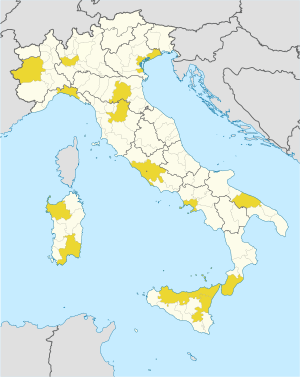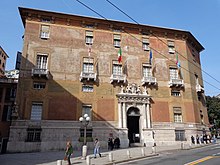Italian metropolitan cities
Italian metropolitan cities with capitals |
The metropolitan cities ( Italian Città metropolitane , Sg. Città metropolitana ) together with the provinces form the middle level of the regional authorities in Italy .
designation
Metropolitan cities are local authorities that extend over the metropolitan area or the area of fourteen major Italian cities and their surroundings. Therefore, the metropolitan cities are also referred to in South Tyrolean official German as large cities with a special status or as large cities with a special status .
Contrary to what the wording suggests, the metropolitan cities are not cities in the actual sense, but administratively delimited city regions which, in addition to the core city, also include a large hinterland . As such, the Italian metropolitan cities are the legal successors of former provinces that have been renamed and given additional functions.
Emergence
In Italian regions with a normal statute, the national government is responsible for establishing the metropolitan cities, while the autonomous regions with a special statute decide this independently.
Ten of the fourteen metropolitan cities are in regions with normal status: As of January 1, 2015, eight of these ten metropolitan cities - Turin , Genoa , Milan , Bologna , Florence , Rome , Naples and Bari - have been the legal successors of the former provinces. The metropolitan city of Venice was established after the local elections in Venice and began operations on August 31, 2015, the metropolitan city of Reggio Calabria on February 2, 2017.
Three of the fourteen Italian metropolitan cities are located in the autonomous region of Sicily , which has the establishment of the metropolitan cities of Palermo , Catania and Messina .
As part of the reorganization of the local authorities in the autonomous region of Sardinia , the metropolitan city of Cagliari was founded. The metropolitan city of Cagliari and the province of Sud Sardegna replaced the province of Cagliari on January 1, 2017. In the other autonomous regions, no metropolitan cities have yet been established: in particular for the province of Trieste - which was dissolved in 2017 - the conversion into a metropolitan city is planned.
The area of the metropolitan cities is congruent with the previous provinces , with the exception of the metropolitan city of Cagliari, whose area has been newly delimited.
In contrast to the case of the German independent cities , there is no provision in Italy for the municipality and the province to be merged into a single entity and thus to become “province-free”. The metropolitan city replaces the province in Italy, but the previous municipalities remain, unless the new bodies decide otherwise.
For example, the city of Milan continues to exist and, together with 133 other municipalities, forms the area of the metropolitan city of Milan (the previous province of Milan). The former provincial capital Milan takes on the function of the capital of the metropolitan city of the same name.
Functions
The metropolitan cities are a body provided for by the Italian constitution, which simultaneously takes on all functions of a province and additional original functions.
Like the provinces, the metropolitan cities are entrusted with the following functions:
- Coordination of spatial planning and protection and enhancement of the environment
- Planning of the transport pick-up services, approvals and controls in the field of individual traffic, construction and operation of roads and regulation of traffic on roads in their area of responsibility
- Planning the school network
- Collection and processing of data, technical and administrative support for local authorities
- School building
- Control of discrimination in the workplace and promotion of equality between men and women in the metropolitan area.
In addition, the metropolitan cities take on the following original functions:
- Elaboration of a three-year strategic spatial plan , which is a guideline for the municipalities in the metropolitan area
- general spatial planning , including communication structures, service networks and infrastructures
- Coordination and organization of public services
- Mobility and traffic
- Promotion and coordination of economic and social development, support for innovation and research
- Promotion and coordination of computerization and digitization .
organization

According to the general legal situation, the mayor (sindaco) of the former provincial capital also becomes the metropolitan mayor (sindaco metropolitano) and thus replaces the former president of the province.
The municipal councils elect the members of the Metropolitan Council (consiglio metropolitano) from among their ranks . The latter has 14, 18 or 24 members depending on the number of inhabitants. In addition, there is the Metropolitan Mayor, who chairs the Metropolitan Council. In addition, the Metropolitan Conference ( conferenza metropolitana ) is a conference of all mayors of the metropolitan area, whose main function is to adopt the statute of the metropolitan city. Otherwise, however, the Metropolitan Conference only becomes active in making fundamental decisions or takes on advisory tasks.
The statute of the metropolitan city may provide for the direct election of the metropolitan mayor and the metropolitan council. The legal requirement for this is that the capital of the former province and the successor body metropolitan city as such is divided into several municipalities and thus replaced by these. A local referendum is required for this. If a metropolitan city has more than three million inhabitants, it is sufficient for a direct election to divide the capital into independent city districts.
The Italian capital, Rome, has had a special status with additional tasks and rights since 2010 and is known as Roma Capitale . In 2015 the official name was transferred to the old province and new metropolitan city of Rome Capital ( Città metropolitana di Roma Capitale ).
Overview
| Metropolitan city | Communities | Population (ISTAT data as of December 31, 2019) |
Area in km 2 |
|---|---|---|---|
| Rome | 121 | 4,333,274 | 5,352 |
| Milan | 134 | 3,279,944 | 1,575 |
| Naples | 92 | 3,082,905 | 1,171 |
| Turin | 316 | 2,252,379 | 6,829 |
| Palermo | 82 | 1,243,328 | 4,992 |
| Bari | 41 | 1,249,246 | 3,821 |
| Catania | 58 | 1,104,974 | 3,552 |
| Florence | 42 | 1,004,298 | 3,514 |
| Bologna | 56 | 1,017,806 | 3,702 |
| Genoa | 67 | 835.829 | 1,839 |
| Venice | 44 | 851.663 | 2,462 |
| Messina | 108 | 620.721 | 3,247 |
| Reggio Calabria | 97 | 541.278 | 3,183 |
| Cagliari | 17th | 431,302 1 | 1,248 |
Web links
- Law No. 56 of April 7, 2014 on Metropolitan Cities, on normattiva.it
- ISTAT codes of metropolitan cities
Individual evidence
- ^ Official Journal of the Trentino-South Tyrol region, Italian-German edition, Ordentliches Supplement No. 1 to the Official Journal of August 28, 1990 - No. 39, page 14
- ↑ Legislative Decree of April 30, 1992, No. 285, New Road Traffic Act, Art. 36 Paragraph 3 ( Memento of June 12, 2015 in the Internet Archive )
- ^ Italian Constitution, Art 114
- ↑ http://www.provincia.venezia.it/notizie/31-agosto-prima-seduta-del-consiglio-metropolitano.html-0 Da lunedì prossimo entra in funzione la Città metropolitana di Venezia = From next Monday the metropolitan city takes Venice started its activity
- ↑ Reggio Calabria Prefecture - District Office of the Government, press release of February 2, 2017: http://www.interno.gov.it/sites/default/files/allegati/comunicato_reggio_calabria_1.pdf Da oggi, pertanto, il Sindaco del Comune capoluogo assume le funzioni di Sindaco metropolitano e la Città Metropolitana opera con il proprio statuto ei propri Organi = Therefore, from today the mayor of the capital takes over the functions of the metropolitan mayor and the metropolitan city becomes active within the framework of its statute and its organs
- ↑ Regional Law (Sicily) No. 15 of August 4, 2015: Archive link ( Memento of October 8, 2015 in the Internet Archive )
- ↑ Regional Law (Sardinia) No. 2 of February 4, 2016, Art. 17 http://www.consregsardegna.it/XVLegislatura/Leggi%20approvate/lr2016-02.asp
- ↑ http://osservatorio.urbanit.it/la-citta-metropolitana-di-cagliari-subentra-alla-provincia-omonima/ La Città metropolitana di Cagliari subentra alla Provincia omonima - Osservatorio Urban @ it = The metropolitan city of Cagliari replaces the city of the same name province
- ^ Ecco le novità della riforma Delrio In: La Stampa April 3, 2014, accessed on May 27, 2014
- ↑ Law No. 56 of April 7, 2014, Art. 1 Paragraph 85
- ↑ Law No. 56 of 7 April 2014, Art. 1 Paragraph 44
- ↑ cf. Law No. 56 of 7 April 2014, justification of the law http://www.governo.it/GovernoInforma/documenti/sintesi_legge_Senato.pdf


